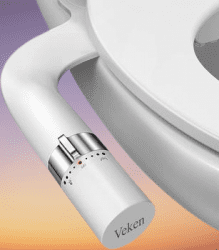why is my bidet not spraying water
Are you frustrated with your bidet not spraying water? This common issue can leave you feeling puzzled and inconvenienced, as the purpose of a bidet is to provide a refreshing and hygienic cleaning experience.
Whether you have recently installed a bidet or have been using one for a while, encountering a lack of water spray can be a perplexing problem. But fear not, as I am here to offer my expertise and guide you through potential solutions. Why Is My Bidet Not Spraying Water?
Don’t panic, it’s not the end of the world. There are some common reasons why your bidet might not be working properly, and some simple solutions to fix them.
In this post, I will share with you some tips on how to troubleshoot your bidet and get it back to its normal function.
Why is there no water coming out of my bidet?
One of the most common reasons why your bidet might not be spraying water is a problem with the water supply. This could be due to a number of factors, such as:
- The water valve is turned off or partially closed. This can reduce or stop the water flow to your bidet. You can check the valve under your toilet tank or near the wall and make sure it is fully opened. You can also try to turn it off and on again to see if that helps.
- There is a leak or blockage in the pipes. This can also affect the water pressure and volume to your bidet. You can inspect the pipes for any signs of damage, such as cracks, holes, or corrosion. You can also look for any water puddles or stains on the floor or the wall. If you find any leak or blockage, you might need to repair or replace the pipes.
- There is a problem with the water source. This could be due to a water outage, a low water level, or a frozen pipe. You can check the water supply in other faucets or appliances in your house to see if they are working. If not, you might need to contact your water provider or wait for the water to resume.
If the water supply is fine, then the problem might be with the bidet nozzle. The nozzle is the part that sprays water to your bum, and it can get clogged by dirt, debris, or hard water deposits over time. Hard water is water that contains high levels of minerals, such as calcium and magnesium. These minerals can build up on the nozzle and reduce its performance.
How do you unclog a bidet nozzle?
To prevent or fix a clogged nozzle, you need to clean it regularly. Here are some steps to clean your bidet nozzle:
- Turn off the water valve and unplug the bidet if it is electric. This will prevent any water or electric shock while you are cleaning.
- Remove the nozzle from the bidet. Depending on your bidet model, you might need to unscrew, pull, or twist the nozzle to detach it. Be careful not to damage the nozzle or the hose.
- Use a soft brush or a toothpick to gently remove any visible dirt or debris from the nozzle holes. You can also use a cotton swab or a cloth to wipe the nozzle surface.
- Soak the nozzle in a solution of vinegar and water for about 15 minutes. This will help dissolve any hard water deposits and sanitize the nozzle. You can use a ratio of one part vinegar to four parts water.
- Rinse the nozzle with clean water and dry it with a soft cloth. Make sure there is no residue left on the nozzle.
- Reattach the nozzle to the bidet. Make sure it is securely and correctly connected. You can use a wrench or pliers to tighten the connection if needed.
- Turn on the water valve and plug in the bidet if it is electric. Test the water spray and see if it works.
If the nozzle is still clogged, you might need to replace it. You can buy a new nozzle from the manufacturer or a local hardware store.
Make sure you get the right size and type for your bidet model. To replace the nozzle, you need to follow the same steps as above, but instead of reattaching the old nozzle, you need to connect the new one. Be careful not to damage the hose or the washer. You can use a wrench or pliers to tighten the connection.
Why is my bidet spraying no pressure?
Another common issue with bidets is low or no water pressure. This can make the water spray weak or ineffective. You can find here a detail guide about “why bidet pressure is low.”
There are a few possible causes for this problem, such as:
- The water valve is not fully opened. You can try to adjust the valve to increase the water flow.
- The water filter is dirty or clogged. You can clean or replace the filter to improve the water quality.
- The hose is kinked or twisted. You can straighten the hose to avoid any obstruction.
- The nozzle is misaligned or damaged. You can adjust or replace the nozzle to ensure a proper spray angle.
How do you troubleshoot a bidet?
If none of the above solutions work, you might need to troubleshoot your bidet further. Depending on the type of bidet you have, you might need to check the sensor, the battery, the remote control, or the electrical outlet. Here are some general steps to troubleshoot your bidet:
- Check the sensor. Some bidets have a sensor that detects when someone is sitting on the seat. If the sensor is dirty, faulty, or covered by something, it might not activate the water spray. You can clean the sensor with a damp cloth or replace it if needed.
- Check the battery. Some bidets are battery-operated, and they might not work if the battery is low or dead. You can replace the battery with a new one of the same type and size.
- Check the remote control. Some bidets have a remote control that allows you to adjust the water temperature, pressure, and mode. If the remote control is not working, it might be due to low battery, interference, or damage. You can replace the battery, move the remote closer to the bidet, or get a new remote if needed.
- Check the electrical outlet. Some bidets are plugged into an electrical outlet, and they might not work if the outlet is faulty, loose, or switched off. You can test the outlet with another device, tighten the plug, or turn on the switch if needed.
If you still can’t fix your bidet, you might need to contact a professional plumber or the manufacturer for assistance. They might be able to diagnose and repair your bidet or offer you a warranty or a replacement.
Conclusion
Bidets are awesome, but they can also have some problems. If your bidet is not spraying water, don’t worry. You can try some of the tips I shared in this blog post to fix it yourself. If you need more help, you can always call a pro. I hope you found this blog post helpful and informative. If you did, please share it with your friends and family who might also have bidet troubles. And don’t forget to leave a comment below and let me know how it went.
FAQs
Can a bidet get clogged?
Yes, a bidet can get clogged by dirt, debris, or hard water deposits over time. This can affect the water spray and the nozzle performance. You can prevent or fix this by cleaning the nozzle regularly with a soft brush, a toothpick, or a vinegar solution. You can also replace the nozzle if it is damaged or worn out.
How do you turn on bidet water?
The way you turn on bidet water depends on the type of bidet you have. Some bidets have a knob, a lever, or a button that you can use to control the water flow. Some bidets have a sensor that detects when someone is sitting on the seat and activates the water spray automatically. Some bidets have a remote control that allows you to adjust the water temperature, pressure, and mode.
What are the negatives to using a bidet?
Some possible negatives to using a bidet are:
- It can be expensive to install and maintain, especially if you need to hire a plumber or an electrician.
- It can use more water and electricity than a regular toilet, which can increase your utility bills and environmental impact.
- It can cause irritation, infection, or injury if the water is too hot, too cold, too strong, or contaminated.
- It can be uncomfortable or awkward to use, especially if you are not used to it or if you have limited mobility or privacy.
How can I make my bidet pressure stronger?
You can make your bidet pressure stronger by:
- Turning on the water valve fully and ensuring there is no leak or blockage in the pipes.
- Cleaning or replacing the water filter to improve the water quality.
- Straightening the hose to avoid any obstruction.
- Adjusting or replacing the nozzle to ensure a proper spray angle.
- Using the remote control to increase the water pressure setting.
How do I increase the water pressure in my toilet bidet?
This question is similar to the previous one. You can increase the water pressure in your toilet bidet by following the same steps as above.
Do bidets get water everywhere?
No, bidets do not get water everywhere if they are used correctly and if they are well-designed. Most bidets have a nozzle that sprays water directly to your bum, and a splash guard that prevents the water from splashing outside the toilet bowl. Some bidets also have a self-cleaning feature that rinses the nozzle before and after each use. However, some water droplets might still escape the bidet, so it is advisable to have a towel or a tissue nearby to dry yourself.
Do bidets also dry?
Some bidets also have a drying feature that blows warm air to your bum after the water spray. This can help you feel more comfortable and hygienic. However, not all bidets have this feature, and some users might find it too hot, too noisy, or too slow. You can use the remote control to adjust the drying temperature, speed, and duration. You can also skip the drying feature and use a towel or a tissue instead.
6of30





